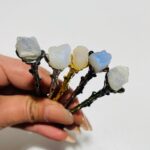Amethyst, a breathtaking purple gemstone, has captivated hearts and minds for centuries. Its alluring hue, ranging from pale lavender to deep violet, has made it a coveted treasure in jewelry and other decorative arts.

History and Origins
Amethyst’s history dates back to ancient times. The Greeks believed it protected against drunkenness, giving it the name “amethystos,” meaning “not drunk.” Ancient Egyptians revered it as a symbol of royalty and protection. In medieval Europe, amethyst was believed to possess healing powers and was often used in amulets and talismans.
Amethyst is primarily found in volcanic rocks and geologically young basalt. The vast majority of global amethyst production originates in Brazil, with significant deposits also present in Zambia, Uruguay, Madagascar, and Russia.
Chemical Composition and Physical Properties
Amethyst is a variety of quartz, a mineral composed primarily of silicon and oxygen. Its distinctive purple color is attributed to trace amounts of iron impurities within the crystal lattice. Amethyst exhibits a Mohs hardness of 7, making it relatively durable and resistant to scratching.
Varieties and Grades
Amethyst occurs in a range of hues and intensities. The most desirable and valuable varieties include:
- Deep Purple Amethyst: Rich, intense purple color
- Medium Purple Amethyst: Moderate purple hue
- Lavender Amethyst: Pale, pastel-like purple
Amethyst is graded based on factors such as color, clarity, and cut. The Gemological Institute of America (GIA) has established a grading system that ranges from Fancy Deep to Faint Purple.
Jewelry and Decorative Usage
Amethyst is highly prized in jewelry. Its versatility allows it to be set in a wide variety of styles, from delicate pendants to opulent earrings. Amethyst is also commonly featured in rings, bracelets, and necklaces, adding a touch of elegance and sophistication to any outfit.
Beyond jewelry, amethyst finds application in decorative arts. It is used in sculptures, carvings, and other decorative pieces. Its natural beauty and mystical aura make it a popular choice for interior design, adding a touch of serenity and enchantment to any space.
Metaphysical Properties and Healing
Amethyst has been associated with various metaphysical and healing properties for centuries. It is believed to promote spiritual growth, enhance intuition, and provide emotional balance. In crystal healing, amethyst is often used to alleviate stress, anxiety, and insomnia. It is also believed to improve focus and concentration.
Consumer Trends and Demand
The demand for amethyst remains strong in both the jewelry and decorative markets. According to a report by the World Gold Council, the global market for purple gemstones is projected to reach $12 billion by 2025. Amethyst accounts for a significant portion of this demand, driven by its unique color, versatility, and perceived metaphysical properties.
Consumers increasingly seek out high-quality amethyst with vibrant colors and clarity. Sustainable sourcing and ethical mining practices are also becoming more important considerations for consumers.
Tips and Tricks for Buying Amethyst
- Color: Choose amethyst with a consistent, vibrant purple hue. Avoid stones with uneven coloring or pale shades.
- Clarity: Opt for amethyst with minimal visible inclusions or imperfections. High-quality amethyst should appear clear and transparent.
- Cut: The cut of amethyst can greatly impact its brilliance and sparkle. Consider various cuts, such as oval, round, or princess, to find the one that best complements your preferences.
- Carat Weight: Larger amethyst gemstones will naturally command a higher price. Decide on the desired carat weight based on your budget and jewelry design.
- Certification: Purchase amethyst that has been certified by a reputable gemological laboratory. This ensures authenticity and provides peace of mind.
Common Mistakes to Avoid
- Mistaking Heat-Treated Amethyst: Some amethyst is heat-treated to enhance its color. While this treatment is common and generally accepted, be aware that heat-treated amethyst may be less valuable than natural amethyst.
- Cleaning Harshly: Amethyst is a relatively durable gemstone, but it can still be damaged by harsh cleaning methods. Use mild soap and water, and avoid ultrasonic cleaners or abrasive chemicals.
- Exposing to Sunlight: Prolonged exposure to sunlight can cause amethyst to fade in color. Store amethyst jewelry in a cool, dark place when not in use.
Inspiration and Innovation
Amethyst’s unique properties have inspired a wide range of innovative applications.
- Optical Crystals: Amethyst crystals can be used in lasers and other optical devices due to their ability to focus and transmit light efficiently.
- Jewelry Lighting: Amethyst cabochons can be incorporated into jewelry designs to create unique and eye-catching lighting effects.
- Mineral Dyes: Amethyst can be ground into a fine powder and used as a mineral dye to create beautiful purple fabrics and other materials.
- Crystal Healing Jewelry: Jewelry incorporating amethyst is often used in crystal healing practices to promote well-being and spiritual growth.
Tables
| Country | Production (tons) |
|---|---|
| Brazil | 12,000 |
| Zambia | 5,000 |
| Uruguay | 3,000 |
| Madagascar | 2,000 |
| Russia | 1,500 |
| Grade | Value per Carat (USD) |
|---|---|
| Fancy Deep Purple | $500-$1,000 |
| Medium Purple | $100-$500 |
| Lavender Amethyst | $50-$200 |
| Property | Benefit |
|---|---|
| Spiritual Growth | Enhances intuition, promotes mindfulness |
| Emotional Balance | Reduces stress, alleviates anxiety |
| Focus and Concentration | Improves mental clarity, stimulates creativity |
| Healing and Protection | Promotes restful sleep, protects against negative energies |
| Application | Description |
|---|---|
| Laser and Optical Devices | Amethyst crystals are used in lasers and other optical devices due to their ability to focus and transmit light efficiently. |
| Jewelry Lighting | Amethyst cabochons can be incorporated into jewelry designs to create unique and eye-catching lighting effects. |
| Mineral Dyes | Amethyst can be ground into a fine powder and used as a mineral dye to create beautiful purple fabrics and other materials. |
| Crystal Healing Jewelry | Jewelry incorporating amethyst is often used in crystal healing practices to promote well-being and spiritual growth. |




























